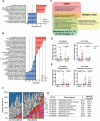TH1 cell-inducing Escherichia coli strain identified from the small intestinal mucosa of patients with Crohn's disease
- PMID: 32691669
- PMCID: PMC7524366
- DOI: 10.1080/19490976.2020.1788898
TH1 cell-inducing Escherichia coli strain identified from the small intestinal mucosa of patients with Crohn's disease
Abstract
Dysbiotic microbiota contributes to the pathogenesis of Crohn's disease (CD) by regulating the immune system. Although pro-inflammatory microbes are probably enriched in the small intestinal (SI) mucosa, most studies have focused on fecal microbiota. This study aimed to examine jejunal and ileal mucosal specimens from patients with CD via double-balloon enteroscopy. Comparative microbiome analysis revealed that the microbiota composition of CD SI mucosa differs from that of non-CD controls, with an increased population of several families, including Enterobacteriaceae, Ruminococcaceae, and Bacteroidaceae. Upon anaerobic culturing of the CD SI mucosa, 80 bacterial strains were isolated, from which 9 strains representing 9 distinct species (Escherichia coli, Ruminococcus gnavus, Klebsiella pneumoniae, Erysipelatoclostridium ramosum, Bacteroides dorei, B. fragilis, B. uniformis, Parabacteroides distasonis, and Streptococcus pasteurianus) were selected on the basis of their significant association with CD. The colonization of germ-free (GF) mice with the 9 strains enhanced the accumulation of TH1 cells and, to a lesser extent, TH17 cells in the intestine, among which an E. coli strain displayed high potential to induce TH1 cells and intestinal inflammation in a strain-specific manner. The present results indicate that the CD SI mucosa harbors unique pro-inflammatory microbiota, including TH1 cell-inducing E. coli, which could be a potential therapeutic target.
Keywords: Escherichia coli; Ruminococcus gnavus; Crohn’s disease; TH1; TH17; double-balloon enteroscopy; microbiome.
Figures




References
-
- Franke A, McGovern DP, Barrett JC, Wang K, Radford-Smith GL, Ahmad T, Lees CW, Balschun T, Lee J, Roberts R, et al. Genome-wide meta-analysis increases to 71 the number of confirmed Crohn’s disease susceptibility loci. Nat Genet. 2010;42(12):1118–1125. PMID: 21102463. doi:10.1038/ng.717. - DOI - PMC - PubMed
-
- Liu JZ, van Sommeren S, Huang H, Ng SC, Alberts R, Takahashi A, Ripke S, Lee JC, Jostins L, Shah T, et al. Association analyses identify 38 susceptibility loci for inflammatory bowel disease and highlight shared genetic risk across populations. Nat Genet. 2015;47(9):979–986. PMID: 26192919. doi:10.1038/ng.3359. - DOI - PMC - PubMed
Publication types
MeSH terms
Supplementary concepts
LinkOut - more resources
Full Text Sources
Medical
